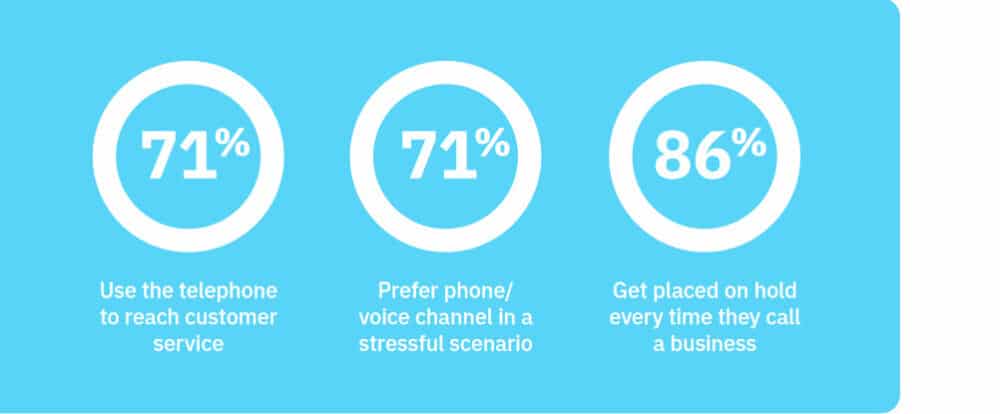In the quest for improved customer satisfaction, contact center managers are making no effort. They’re even starting to pay attention to what callers hear while waiting on hold. Could streaming music on hold service provide the sophistication yet simplicity needed to satisfy weary callers?
Easy On Hold®, a technology and content provider in Michigan, is helping contact centers integrate streaming audio to satisfy callers while they experience dreaded “hold time.” Due to a lack of robust MOH options in contact center communications platforms, the company has generated efficiencies in connecting callers to audio experiences that had been impossible until now. In this article, we will name the platforms that have adopted the streaming MOH concept and give examples of how contact centers are improving caller satisfaction with streaming MOH.
How did we get here?
The term MOH refers to either “music on hold” or “messages on hold”. Its original purpose was to reassure callers that they were still connected while waiting to talk to someone.
How it came to be is a bit of folklore. As the story goes, in 1962, a fellow named Alfred Levy discovered a problem with the phone lines at his factory. He located a loose wire that was touching a steel girder on the building, which apparently had picked up music being transmitted by a nearby radio station. Callers heard the radio station on the phones. Levy’s patent for his on hold electric circuit was awarded in April of 1966. In the years to follow, businesses and phone systems would adopt music (or beep tones) as standard on-hold fare, sounds that customers would ultimately loathe.
The On Hold Dilemma
The calls keep coming in, and the calls keep getting placed on hold.
Easy On Hold® founder Timothy Brown calls it “The On Hold Dilemma 1”. “A growing customer base means there will always be inbound calls, but getting placed on hold seems inevitable,” he says. Brown and his team have dedicated more than 23 years to solving the “dilemma”.
Surveys reveal that the phone is still the preferred method of contacting a business. The 2019 Microsoft State Of Customer Service Report 2 asked consumers, “Which channel would you ideally prefer to use?” In the US, 41% said phone (voice), 15% said live chat, and 13% preferred Email. Globally, 71% of consumers say they use the telephone to reach customer service.
The 2020 CGS study 3 goes further, noting that in a stressful scenario, such as billing inquiries and technical support, 71% of respondents prefer phone support.
How important are these inbound contact center experiences? 71% say they won’t use a brand at all if they cannot talk to a human agent. Google reports 4 that 61% of mobile phone users will call a business while in the purchase phase of a buying cycle. Lost calls amount to lost customers. When do you lose the call? When your customer perceives she is being ignored.
86% of consumers say they’re placed on hold every time they call a business. Of those, two-thirds hang up after 2 minutes on hold, and 13% say they won’t wait at all.

The Forgotten Feature
Making messages on hold play to callers seemed simple during the era of on-premise PBX phone systems. An audio player device could store and play audio into a hold circuit. But as SIP became the norm, the on-premise box was replaced with VoIP platforms (often hosted). For contact centers, sophisticated unified communications platforms allow efficiency through a convergence of voice and data and hopefully long-term cost savings.
Platform providers make claims such as “seamless user experiences” and “powerful customer connections.” One provider promises to be a “force for brilliance.”
Yet so often, the modern unified communications platform employs a rather primitive way of dealing with content on hold. Load a file that loops over and over? Callers hearing the same 30 seconds of music every time they are placed on hold or transferred? Who will change the file? How quickly?
Did moving to the UC platform send MOH back to the ’70s? Did someone forget about the MOH feature?
A flexible, simple, automated MOH solution is needed to retain, inform, and satisfy callers before they abandon your brand.
Introducing Enterprise Music On Hold™ Streaming Hold Music Service
STREAMING. SCALABLE. END-TO-END. AUTOMATED.
By “enterprise music on hold”, EOH refers to a streaming, scalable, end-to-end, customized and automated MOH solution that can be adopted by contact center platforms. This differs from traditional MOH, which is file-based and static.
As it turns out, messages on hold actually work. Over three decades, various studies have concluded that providing information callers can use is the key to keeping them from hanging up, and making them feel as though their call was productive and service-oriented.
With EMOH™, callers never hear an out-of-date message, a fact that empowers marketers to promote valuable, short-term announcements. Higher-priority messages play enough to ensure that a majority of callers have heard the news. Rather than waiting for the audio loop to start over (and over), callers are unable to predict what is happening, leading to the perception that their hold time has been shorter than in real-time.
EMOH™ Integrations for Streaming Hold Music Service
SIX ENTERPRISE CONTACT CENTER PLATFORMS USING EMOH™ AS OF JANUARY, 2021
Platform: Cisco UCCE/PCCE CVP with VVB
Solution: Streaming Queue Music cloud or on-prem appliance (VM Ware). Streams are PCM 8 Bit. (Easy On Hold® is a Cisco® solutions partner.)
In the Spring of 2019, Easy On Hold® was chosen by Cisco® to develop the only Cisco-supported solution for streaming live content into VVB for callers in queue. The solution provided both in the cloud and on-premise, has been fully validated by Cisco® for use in VVB version 12.5.
Platform: Cisco® UCCX/CUCM version 11.5+
Solution: RTP 8-bit stream from an on-premise Easy On Hold® 2-Channel Business Audio System or an off-premise EOH Streaming Queue Music™ cloud service.
Multicast must be enabled on the MOH server but not across the entire V-Lan or subnets. The 2CBAS appliance presents streaming content to the network as an IP address.
Platform: Avaya Aura® MS 7.7+
Solution: http or hls URL.
EOH has clients using HTTP and HLS formatted streams in Avaya call center environments. Avaya Aura® MS supports up to 64 music streams. If the streaming server is unreachable at any time, 15 minutes of audio are automatically recorded and used as a backup.
Platform: Genesys Engage™ on-premise communications platform with MCP v 8.5.161.34+
Solution: EOH Streaming Queue Music platform (cloud or premise).
Easy On Hold® and Genesys, along with Genesys partners, have devised a very effective and efficient streaming service for contact centers on the Genesys Engage™ platform. Extensive knowledge of the Genesys MCP (media control platform) is required.
Platform: Genesys Pure Connect™ Customer Experience Application (on-premise)
Solution: On-site media server connected to custom EOH URI.
Genesys has rebranded what once was the Interactive Intelligence platform. Easy On Hold® has experience using an on-premise streaming media server as a solution.
Platform: Asterisk/Free PBX
Solution: http mp3.
Asterisk has long been able to use a streaming-held music service. Today, all current Asterisk® platforms provide the use of the native Linux mpg-123 audio player as a source for MOH streams. FreePBX® makes setup rather simple: In the music on hold menu, click “Add Streaming Category” and enter the mpg-123 command line, which looks something like usr/bin/mpg123 -q -r 8000 -f 8192 –mono -s ttp://streaming3.easyonhold.com:80/streaming/54321.
SEVEN BUSINESS COMMUNICATIONS PLATFORMS ABLE TO USE STREAMING QUEUE MUSIC™
Platform: Bicom Systems™ PBXWare™ 4.1+
Solution: http stream from EOH.
Bicom Systems™ has partnered with Easy On Hold® since version 4.1 to give users a more productive Music on Hold option. Deployment is as simple as copying and pasting.
Platform: FreeSWITCH™
Solution: Cloud stream from EOH.
Mod Shout is a FreeSWITCH™ module that allows the use of HTTP .mp3 stream audio. The mod_shout module, created by Belaid Areski, last modified by Attila Gulyas on December 23, 2019, is a generally accepted method for replacing the default MoH with a live internet streaming audio feed.
Platform: FusionWorks™ hosted VoIP
Solution: EOH stream on FusionWorks™ proprietary platform.
In 2018, Easy On Hold® worked with Megapath (now Fusion Connect) to create an accessible streaming audio solution for music and messages on hold. Engineers chose to build a streaming media server to integrate audio streams on FusionWorks into customer telecom accounts.
Platform: Fortinet® FortiVoice on-premise IP PBX appliance
Solution: EOH https stream (short URL).
In the FortiVoice appliance application, under phone system > audio > on hold, create a name for your stream, select streaming mode, and enter the URL. Your version of FortiVoice may limit the number of characters in the URL; otherwise, streaming MOH on FortiVoice is very straightforward.
Platform: Cisco® Broadsoft Broadworks – Various applications
Solution: SIP stream from Easy On Hold® cloud.
Broadsoft Broadworks will point calls on hold to a stream coming in on a SIP address. Until now, the only method for delivering such a stream required the addition of expensive on-premise equipment. Currently in use by EOH customers on TPX and Nextiva (VoIP providers on the Broadworks platform).
Platform: IPitomy® on-premise IP PBX appliance
Solution: EOH https stream URL.
Streaming is an option in IPitomy when configuring MOH, but the stream is still referred to as a “playlist.”
MOH Shifts To Marketing
If you are responsible for changing the MOH audio files, you should investigate EMOH™. Now is the time to bring the marketing department in to manage all content.
Authorized content managers will use a content management portal to request, approve and schedule music and messaging content.
Easy On Hold’s® Enterprise Music On Hold™ solution is deployed as the proprietary Streaming Queue Music™ (SQM) appliance, either in the cloud or on-premise. The appliance intakes audio stream(s) and outputs streaming audio in the needed format. Bitrates and sample rates are configurable, as is audio equalization and volume. Any URLs used for your communications platform will not change over time.
Of course, the SQM dashboard provides reporting and management of the streaming appliance or cloud solution. Stream status and connectivity are continuously monitored. Any interruption is instantly detected, triggering a switch to redundant (failover) streams. All stream activity is logged.
The streaming solution is scalable enough to provide multiple content streams from a single appliance. One contact center may have unique MOH content for various queues based on service, support, regions, etc.
With Streaming Hold Music Service, Marketing manages the content.
Marketing has its own dashboard for content management. Marketers can request a new topic, approve a script, approve audio, set and change schedules, and immediately start and stop individual topics. Pre-recorded announcements can be added to the stream at a moment’s notice. Email and text notifications provide alerts when a script or new audio is ready for approval and when a current topic is nearing the end of its schedule.
Messages can be programmed by “time-of-day” and “day-of-week.” For example, an EOH customer has call volumes (and caller time-on-hold) that predictably increase between 11 am and 1 pm weekdays. During that time, messages with more music and less speaking are automatically deployed to avoid message burn-out. Callers hear about alternative ways to get answers to their questions.
The COVID pandemic has caused many operations to change hours. Callers hear, “Today’s hours are…” and “Tomorrow we are open from…”
A hospital system in Florida has pre-recorded messages they can instantly deploy (with a single mouse click) when a hurricane threatens their area.
The Ultimate Goal: Satisfaction
Can contact center technology enhance the customer experience? Yes, but include the new EMOH™ technology as part of your strategy.
In the pursuit of excellence at your contact center, streaming MOH can help.
Up-selling, cross-selling, customer retention—all are important. But when hold times, no matter how brief, add friction to the customer journey, overall satisfaction suffers.
Leveraging streaming MOH technology opens up communications opportunities by delivering targeted messaging at a critical moment in the customer journey. Unique, relevant caller experiences create retention and engagement. Help, educate, encourage, and entertain your customers, and they won’t go away. Is it time to investigate the Enterprise Music On Hold streaming hold music service?
RESOURCES
1 Timothy Brown, The On Hold Dilemma. https://easyonhold.com/knowledgebase/The_Phone_On_Hold_Dilemma_Whitepaper_by_Easy_On_Hold.pdf
2 Microsoft State Of Customer Service Report. https://info.microsoft.com/ww-landing-global-state-of-customer-service.html
3 CGS Survey. https://www.cgsinc.com/en/resources/2019-CGS-Customer-Service-Chatbots-Channels-Survey
4 Google Ipsos Survey. https://www.thinkwithgoogle.com/marketing-strategies/app-and-mobile/click-to-call/
5 Arise Survey. https://www.arise.com/resources/blog/arise-customer-service-frustration-series-phone-hold-times






